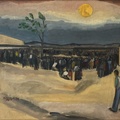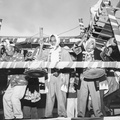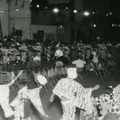In the spring of 1942, people of Japanese descent living on the American West Coast were incarcerated by the U.S. government in temporary detention centers hastily built on fairgrounds, racetracks, former labor camps, and livestock facilities. Despite facing innumerable hardships and uncertainties, the new communities quickly established schools, sports teams, work crews, adult classes, religious groups, and other activities and organizations. As spring turned to summer, Independence Day was celebrated in the detention centers, not without some deep resentment, and plans were made for Obon, a Buddhist memorial for the dead usually observed around the days of July 15 or August 15.1
Obon had been celebrated in the continental United States at least since the arrival of Japanese Buddhist ministers in the 1890s with religious services, visits to family graves, offerings, lanterns, and other rituals. Bon odori (Obon dancing), unison dances in a circle, often around a yagura (platform), was introduced to Buddhist communities in the early 1930s by Reverend Yoshio Iwanaga, who traveled up and down the West Coast from Vancouver, British Columbia to Los Angeles, California, conducting religious services and teaching dance. In 1933, Teruko Naito, wife of Reverend Shozen Naito, taught Bon odori in Sacramento and Reverend Masao Washioka led dance classes in Northern and Southern California.
Within a few short years, Bon odori had become an indispensable part of Buddhist Obon celebrations and Japanese cultural events alike in the continental United States. In many locations, a booming taiko (drum) accompanied the recorded dance music, and in places like Guadalupe, Los Angeles, and Seattle, lively dancers contributed to the festive atmosphere by masquerading as samurai, geisha, hula dancers, sailors, or comic figures.
Throughout incarceration, Obon remained an important holiday as a memorial for the dead, and Bon odori was cherished as an activity that united the community in joy and remembrance. While Bon odori did not occur in some detentions centers due to closures before the Obon season, unfavorable conditions within the centers, or prohibition by the administration, the celebration of Obon with Bon odori was observed in Merced, Pinedale, Pomona, Stockton, Tanforan, and Tulare. In addition, Bon odori was included in Puyallup’s Independence Day program and was the final number in Portland’s mid-July Talent Revue.2
Obon organizers in Pomona anticipated 1,000 dancers and decorated the dance area and yagura with streamers, pennants, and flowers. The Tulare Obon featured 700 dancers under lines of paper lanterns, and Stockton counted 500 dancers and 3,500 spectators.
Bon odori was taught by Yoshiko Fujimoto, Miye Ichiki, and Yukichi Nishiyori in Pinedale and supervised by Mrs. Higaki, Mrs. Kato, and Mabel Furukawa in Merced, where the camp newspaper reported, “More than 400 bon odori enthusiasts clad in shimmering kimono appeared in a huge oval in front of the Grandstand.” Obon planners in Merced even attempted to locate taiko drummers, implying that they had a taiko, or at least a drum, to accompany the dances.3
And at the Santa Fe camp, run by the Department of Justice from February 1942 until September 1946, the all-male population observed Obon with Buddhist services, Bon odori, a yagura decorated with lanterns, and a large taiko. In addition, some of the men dressed as women for the dancing using costumes from the camp’s amateur kabuki group.4

From May to November 1942, the incarcerated population was moved to more permanent concentration camps constructed further inland in barren scrublands, swamplands, and deserts. Obon with Bon odori was celebrated in all ten of the concentration camps administered by the War Relocation Authority (WRA). The earliest was held on July 18 and 19, 1942 at Tule Lake in California. The latest took place on July 14 and 15, 1945 at Rohwer in Arkansas, and July 15, 1945 at Gila River’s Butte camp in Arizona.
Bon odori in the concentration camps involved hundreds of dancers and thousands of spectators. As such, volunteer organizers had a myriad of tasks to undertake, from gaining permissions, communicating with the camp staff, and acquiring sound and lighting equipment, to holding dance classes, preparing the grounds, and decorating. A number of communities even printed Obon posters and programs, organized a bazaar, prepared refreshments, built a yagura, or obtained or made a taiko.
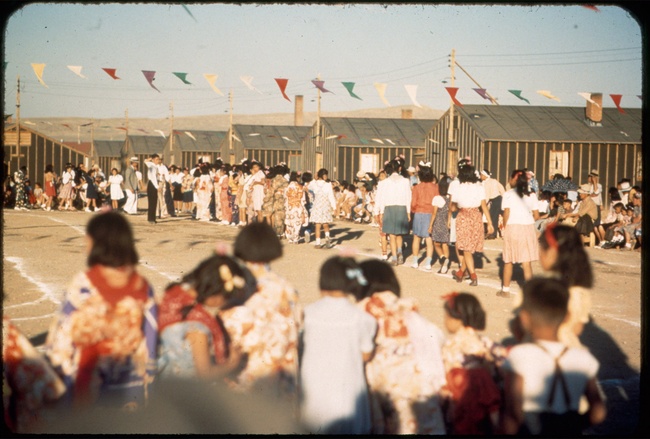
But one by one, these tasks would be completed, and as evening approached, people would gather for the Bon odori—some in everyday clothes, some having changed into their nicest outfits, and others wearing the family’s treasured kimono, carefully packed and transported to a desolate new home. Music played over the loudspeakers, spotlights beamed over the crowd, dancers took their places, and with the wind and dust blowing through the circle, the dancing would begin.
Here are glimpses of Bon odori from a single Obon season between 1942 and 1944 at each of the ten WRA concentration camps.5
Amache (Granada)
Bon odori practices at the Amache concentration camp began in late July 1943 at two outdoor locations with shaved ice served during breaks. Volunteers cleaned the camp cemetery on August 8, and Obon services took place at the high school auditorium on the weekend of August 14 and 15. Bon odori was planned for both evenings at the 10F athletic field with recorded music accompanied by Frank Koshiro Kumagai and Jutaro Eugene Gondo, perched on a tall yagura playing a shime daiko (rope-tied drum), hyoshige (wooden clappers), and a western bass drum. Dances included “Goshu Ondo,” “Kagoshima Okesa,” “Sado Okesa,” “Sakura Ondo,” “Shinsaku Bon Odori,” and “Ureshikaro.”
As the Granada Pioneer reported, “Close to a thousand participants, the majority of them dressed in colorful kimonos, danced in three concentric circles.” While Sunday evening was rained out, Bon odori was rescheduled for Monday.6
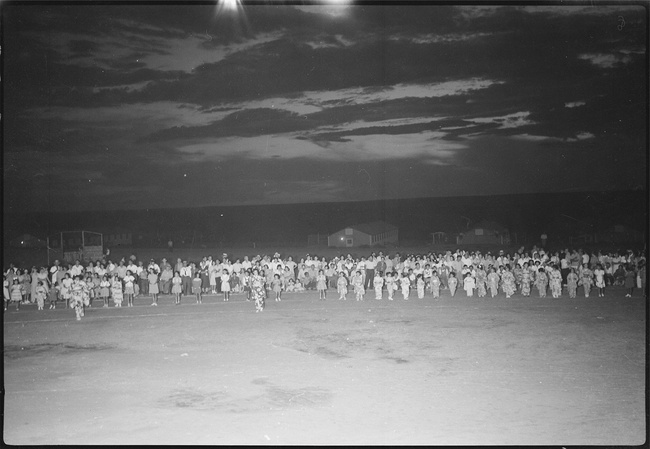
Gila River
Comprising two separate camps known as Canal and Butte, the Gila River concentration camp was initially populated between July and August 1942. The Canal Buddhist Church opened in mid-September and celebrated Obon on September 27. Over 300 youths, most wearing kimono and carrying fans and kachi-kachi (bamboo clappers), performed three sets of five dances to an estimated 5,000 spectators. An older man played a taiko made in the camp from an animal skin stretched over a keg, and a number of adults entertained the crowd masquerading as characters like a samurai with straw armor and swords and an onion bestowing good fortune.
As noted by anthropologist Robert Spencer, “A man dressed as Charlie Chaplin as well as a man parodying a western woman attempting to do the Bon dance were, with their clowning, providing considerable comic relief.” The Butte camp opened later and held its first Obon in 1943.7
Heart Mountain
Bon odori dancers at the Heart Mountain concentration camp had at least three opportunities to dance in the summer of 1943. The nondenominational Heart Mountain Buddhist Church started Bon odori practices in late June and held its Obon program on the weekend of July 10 and 11 with morning and afternoon services and Bon odori on Saturday evening at the block 17 lot with approximately 1,000 dancers. A few days later, the Nishi Hongwanji and Nichiren churches held a joint Obon with services on July 14 and Bon odori on July 15 at the block 25 field. Bon odori teachers included Miyeko “Mickey” Azeka and Kimiko Tamura. Later in mid-August, the newly made butsudan (shrine) by brothers Shinzaburo and Gentaro Nishiura was installed at the Nishi Hongwanji Church with afternoon services and Bon odori in the evening, attracting approximately 400 dancers.8
Bon odori at Heart Mountain’s Obon, 1943 or 1944. Japanese American Film Preservation Project Collection via Densho Digital Repository, ddr-densho-1005-1-22. (Eiichi Edward Sakauye)
Jerome
In May 1943, the two-day Carnival at the Jerome concentration camp featured food, a talent show, baseball and basketball games, and concluded with a raffle and Bon odori led by Block 17 residents. In early July, nightly dance practices began in preparation for the Denson Buddhist Church’s Obon on July 17 and 18. Memorial services were held throughout the Obon weekend at Dining Hall 23 with a special evening service at the outdoor stage, illuminated by large paper lanterns. Fusaye Ozaki, Midori Seo, and Kaoru Shimada led several hundred dancers in “Bon Odori Uta,” “Kagoshima Ohara Bushi,” “Nagoya Yoitoko,” and “Tokyo Jinku” on the softball field between blocks 9 and 11. On the second night, a group of twenty-five dancers from the Rohwer Young Buddhist Association also joined the circle. Shaved ice and cold drinks were sold and the Denson Tribune estimated “several thousand spectators on hand.”9
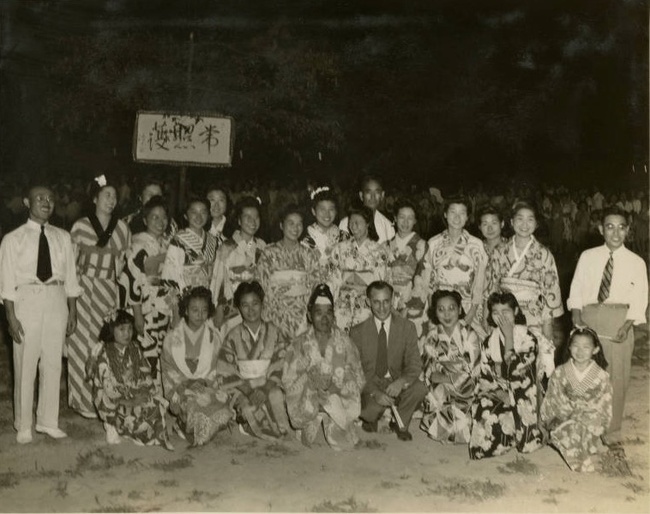
* * * * *
* * * * *
Notes
1. Obon was traditionally observed on the 15th day of the 7th month of the lunar calendar with rituals beginning on the 13th and lasting until the 15th or 16th. With the adoption of the solar Gregorian calendar during the Meiji era, locales either retained the lunar calendar (celebrating Obon between early August and early September), translated the date to the new solar calendar (July 15), or most commonly, adjusted the date to more closely approximate the lunar calendar (August 15).
2. Portland hosted a “Bon Festival” in July 1942 which may have included Bon odori. The Marysville, Mayer, Sacramento, and Salinas detention centers closed before the Obon season. It is unlikely that an Obon with Bon odori occurred in Fresno, Santa Anita, and Turlock. Additionally, there are no indications of Bon odori at the concentration camps in Hawai‘i.
3. “Odori—Success,” The Mercedian (July 21, 1942): 4. See also The Mercedian, July 14, 1942, 1; Pinedale Logger, July 3, 1942, 10; Pomona Center News, July 29, 1942, 4; The Tulare News, Aug. 1, 1942, 4; Aug. 5, 1942, 3.
4. Minako Waseda, “Extraordinary Circumstances, Exceptional Practices: Music in Japanese American Concentration Camps,” Journal of Asian American Studies 8, no. 2 (2005): 188-190; Yasutaro Soga, Life behind Barbed Wire: The World War II Internment Memoirs of a Hawai‘i Issei, trans. Kihei Hirai (Honolulu: University of Hawai‘i Press, 2008), 155.
5. The information presented here is based largely on detention center newsletters, concentration camp newspapers, and administration documents.
6. “Obon Festival is Big Success,” Granada Pioneer, August 18, 1943, 3. See also Granada Pioneer, July 28, 1943, 7; Aug. 4, 1943, 3; Aug. 7, 1943, 7; Aug. 11, 1943, 1; Aug. 14, 1943, 1, 4, 8.
7. Robert Spencer, “Religious Life in the Gila Community, November 2, 1942,” BANC MSS 67/14 c, folder K8.51, page 22. Japanese American Evacuation and Resettlement Records, The Bancroft Library, University of California, Berkeley. See also Gila News-Courier, Sept. 30, 1942, 5; Aug. 14, 1943, 3; Aug. 21, 1943, 3.]
8. Heart Mountain Sentinel, July 10, 1943, 2; Aug. 21, 1943, 2; Sentinel Supplement, June 30, 1943, 2; July 13, 1943, 3.
9. “Thousands Witness Obon Festival Here,” Denson Tribune, July 20, 1943. See also Denson Tribune, May 28, 1943, 8; July 16, 1943, 1, 5; July 20, 1943, 6.
© 2024 Wynn Kiyama



